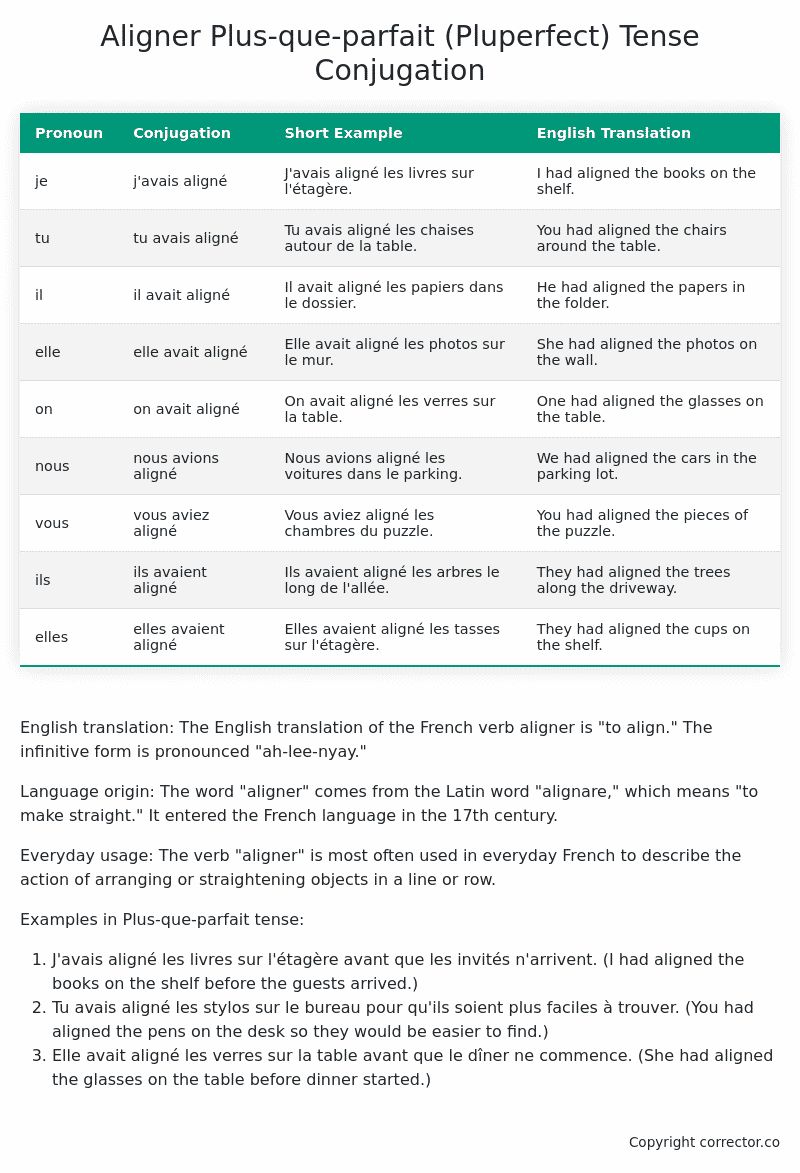Plus-que-parfait (Pluperfect) Tense Conjugation of the French Verb aligner
Introduction to the verb aligner
English translation: The English translation of the French verb aligner is “to align.” The infinitive form is pronounced “ah-lee-nyay.”
Language origin: The word “aligner” comes from the Latin word “alignare,” which means “to make straight.” It entered the French language in the 17th century.
Everyday usage: The verb “aligner” is most often used in everyday French to describe the action of arranging or straightening objects in a line or row.
Examples in Plus-que-parfait tense:
- J’avais aligné les livres sur l’étagère avant que les invités n’arrivent. (I had aligned the books on the shelf before the guests arrived.)
- Tu avais aligné les stylos sur le bureau pour qu’ils soient plus faciles à trouver. (You had aligned the pens on the desk so they would be easier to find.)
- Elle avait aligné les verres sur la table avant que le dîner ne commence. (She had aligned the glasses on the table before dinner started.)
Table of the Plus-que-parfait (Pluperfect) Tense Conjugation of aligner
| Pronoun | Conjugation | Short Example | English Translation |
|---|---|---|---|
| je | j’avais aligné | J’avais aligné les livres sur l’étagère. | I had aligned the books on the shelf. |
| tu | tu avais aligné | Tu avais aligné les chaises autour de la table. | You had aligned the chairs around the table. |
| il | il avait aligné | Il avait aligné les papiers dans le dossier. | He had aligned the papers in the folder. |
| elle | elle avait aligné | Elle avait aligné les photos sur le mur. | She had aligned the photos on the wall. |
| on | on avait aligné | On avait aligné les verres sur la table. | One had aligned the glasses on the table. |
| nous | nous avions aligné | Nous avions aligné les voitures dans le parking. | We had aligned the cars in the parking lot. |
| vous | vous aviez aligné | Vous aviez aligné les chambres du puzzle. | You had aligned the pieces of the puzzle. |
| ils | ils avaient aligné | Ils avaient aligné les arbres le long de l’allée. | They had aligned the trees along the driveway. |
| elles | elles avaient aligné | Elles avaient aligné les tasses sur l’étagère. | They had aligned the cups on the shelf. |
Other Conjugations for Aligner.
Le Present (Present Tense) Conjugation of the French Verb aligner
Imparfait (Imperfect) Tense Conjugation of the French Verb aligner
Passé Simple (Simple Past) Tense Conjugation of the French Verb aligner
Passé Composé (Present Perfect) Tense Conjugation of the French Verb aligner
Futur Simple (Simple Future) Tense Conjugation of the French Verb aligner
Futur Proche (Near Future) Tense Conjugation of the French Verb aligner
Plus-que-parfait (Pluperfect) Tense Conjugation of the French Verb aligner (this article)
Passé Antérieur (Past Anterior) Tense Conjugation of the French Verb aligner
Futur Antérieur (Future Anterior) Tense Conjugation of the French Verb aligner
Subjonctif Présent (Subjunctive Present) Tense Conjugation of the French Verb aligner
Subjonctif Passé (Subjunctive Past) Tense Conjugation of the French Verb aligner
Subjonctif Imparfait (Subjunctive Imperfect) Tense Conjugation of the French Verb aligner
Subjonctif Plus-que-parfait (Subjunctive Pluperfect) Tense Conjugation of the French Verb aligner
Conditionnel Présent (Conditional Present) Tense Conjugation of the French Verb aligner
Conditionnel Passé (Conditional Past) Tense Conjugation of the French Verb aligner
L’impératif Présent (Imperative Present) Tense Conjugation of the French Verb aligner
L’infinitif Présent (Infinitive Present) Tense Conjugation of the French Verb aligner
Struggling with French verbs or the language in general? Why not use our free French Grammar Checker – no registration required!
Get a FREE Download Study Sheet of this Conjugation 🔥
Simply right click the image below, click “save image” and get your free reference for the aligner Plus-que-parfait tense conjugation!

Aligner – About the French Plus-que-parfait (Pluperfect) Tense
Tense Formation
Common everyday usage patterns
Sequencing of past events
Background information
Hypothetical or reported speech
Interactions with other tenses
Summary
I hope you enjoyed this article on the verb aligner. Still in a learning mood? Check out another TOTALLY random French verb conjugation!


